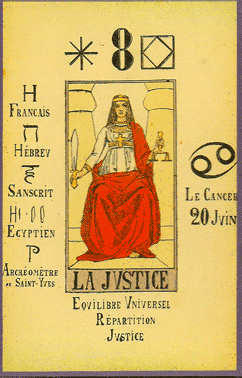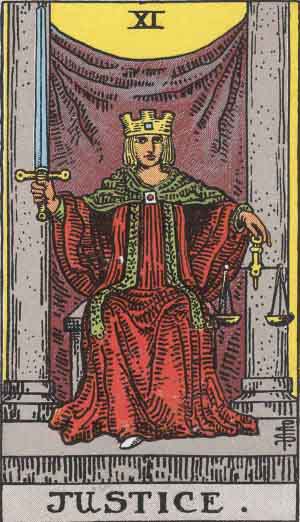Tarot Deep Dive - Justice
- Dustin
- Aug 14, 2021
- 5 min read
Every card represents an aspect of humanity that has echoed through time. In this series we are going to dive into the history of the imagery found within the tarot, the meaning of the cards and how that meaning changed over time, and the symbols present within the images of what is arguably the most well known tarot deck of all time - the Rider-Waite (Smith) Tarot Deck. So grab your favorite RWS deck, a cup of tea or coffee, and join me live on Sunday mornings over on YouTube as we Deep Dive into each one of the 21 Major Arcana cards continuing now with Lady Justice.
Justice, Lady Justice, Daughter of the Lord of Truth, Adjustment

The origin of Lady Justice as we know here today, a blindfolded woman clad in a flowing toga carrying scales and a sword, comes from the Roman Goddess - Justitia (Iustitia), introduced by the emperor Augustus in the first century. She rapidly became the ideal which every emperor after wanted to align themselves with. She, as many of the roman pantheon, was based off the Greek goddess Dike, who is often depicted with a set of scales was the goddess of justice and the spirit of moral order and fair judgement in all aspects of human life, while her mother Themis ruled over divine justice.
Yet, the ideal of Justice, a virtue long coveted by many societies across the world has been long regarded with reverence and considered to be a cornerstone hallmark of a civilized society. In the ancient Egyptian Book of the Dead - or as it was actually known to the Egyptians: The Book of Going Forth By Day we find a similar ideal represented in the depiction of scales associated with the weighing of ones heart in the Hall of Judgement as you passed into the afterlife. Here the deceased would meet Ma'at the goddess of truth, justice, balance, and order who would weigh a persons heart against the feather of truth before Osiris, Anubis, and Thoth with . If their heart was heavy their journey into the afterlife, and to eventual resurrection would end, as Ammut (Ammit, Ahemait, Ammemet) devoured their heart. Once Ammut swallowed the heart, the soul was believed to become restless forever; this was called "to die a second time".

In Christianity we see the figure of Justice appear again as one of the Four Cardinal Virtues: Prudence, Justice, Fortitude, and Temperance. All of which make an appearance in the Minchiate Etruria tarot from 1806, and some but not all take up permanent residence in the Major Arcana of Tarot right through to today. The Cardinal Virtues were often depicted as four women, and Justice in particular again appears with her scales in hand.

All through human history and society we see Lady Justice appear to us in some shape or form inevitably landing her a permanent position in the Major Arcana of the Tarot.
A Note on Ordering

In many decks today you will find Justice in one of two places in your Major Arcana: position VIII or XI. Historically many ancient decks position Justice as Key VIII. It was not until the Golden Dawn did this change. In the Golden Dawn's attempt to create better correspondences to the major arcana with the astrological zodiac they chose to change the numbering of Justice and Strength in which under which the eighth card is associated with Leo and the eleventh with Libra. According to Decker and Dummett in A History of the Occult Tarot this swap was originally suggested in the mysterious Cipher Manuscripts which formed the basis for the Golden Dawn's teachings regarding tarot and other subjects.
Visual Evolution
Our image of Justice has remained very much unchanged throughout history, from our her first appearances in hart history right through the depiction of Justice in various different Tarot decks including those we see here. It is worth noting that none of the cards shown above appear blindfolded except Crowley's Adjustment, where just is not blindfolded but instead masked. Though there is no clear evidence as to why this may be the case considering Lady Justice was so often depicted as blindfolded since the 16th century to represent impartiality, the ideal that justice should be applied without regard to social status, wealth, or power. The first known representation of blind Justice is Hans Gieng's 1543 statue on the Gerechtigkeitsbrunnen (Fountain of Justice) in Berne. Though we do see an art historical precedent to omit the blindfold that evolves along side throughout history. This is thought to be because Lady Justice was originally not blindfolded, as we see her depicted as Dike and in other ancient references, and because her "maidenly form" is supposed to guarantee her impartiality which renders the blindfold redundant.
Evolution of Meaning
De Mellet (1781): Justice.
Levi (1855): The Hebrew letter Cheth. Justice. Balance, attraction and repulsion, life, terror, promise and threat.
Mathers (1888): Themis, or Justice. Equilibrium, balance, justice.
Golden Dawn (1896): Daughter of the Lord of Truth, Holder of the Balances. Justice. Strength arrested in the act of judgement. Legal Proceedings, a court of law, a trial by law.
Waite (1910): Justice. Equity, probity, vindication.
Crowley (1944): This card represents the sign of Libra, ruled by Venus; in it Saturn is exalted. The equilibrium of all things is hereby symbolized. It is the final adjustment in the formula of Tetragrammaton, when the daughter, redeemed by her marriage with the Son, is thereby set up on the throne of the mother; thus, finally, she "awakens the Eld of the All-Father."
The Symbols
The Scales

A set of scales typically suspended from one hand, upon which she measures the strengths of a case's support and opposition. These not only represent Libra in the case of The Rider Tarot, but they represent the harmony and balance of all things.
The Sword

The action of justice in the world. The sword represented authority in ancient times, and conveys the idea that justice can be swift and final.
Hand Gesture

The hand gesture here echoes that of the magician. As above, so below. Representing the divine nature of the justice of all things.
Columns & Violet Cloth

The grey columns are thought to possible represent neutrality. Per Waite; "seated between two pillars, like the High Priestess...indicate(s) that the moral principle which deals unto every man according to his works. The pillars of Justice open into one world... the pillars of the The High Priestess into another..."
The Crown

This represents Kether and divine justice. The square is thought to be a masonic reference to the set-square, a symbol of morality and truth. As Cirlot says in his classic dictionary of symbols, "Symbolizes in the vary broadest and deepest sense, the very idea of preeminence."
As always be sure to check out our live discussion on this very topic over on YouTube:
References
Butler, B. Dictionary of the Tarot. New York: Schocken Books, 1986.
Chang, T. Susan. Tarot Correspondences: Ancient Secrets for Everyday Readers. Llewellyn Pulbications, 2018.
Crowley, Aleister (aleister Crowley). Book of Thoth - (Egyptian Tarot). Red Wheel/Weiser, 2017.
Dean, Liz. The Ultimate Guide to Tarot: a Beginners Guide to the Cards, Spreads, and Revealing the Mystery of the Tarot. Fair Winds Press, 2015.
Decker, Ronald; Dummett, Michael. A History of the Occult Tarot. London: Duckworth, 2019.
Fiebig, Johannes, and Evelin Burger. The Ultimate Guide to the Rider Waite Tarot. Llewellyn, 2013.
Katz, Marcus. Secrets of the Waite-Smith Tarot: the True Story of the Worlds Most Popular Tarot: with Previously Unseen Photography & Text from Waite & Smith. Llewellyn Publications, 2015.
Waite, A. E. Pictorial Key to the Tarot. Dover Publications Inc, 2005.
Wen, Benebell. Holistic Tarot. North Atlantic Books, 2015.
https://en.wikipedia.org/wiki/Lady_Justice
Images Sourced From: https://en.wikipedia.org/wiki/Wikipedia:Public_domain_image_resources












